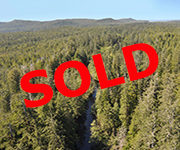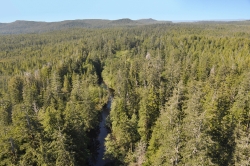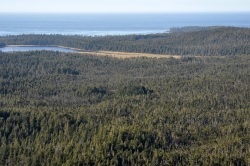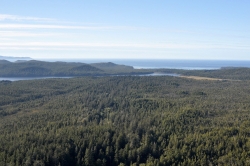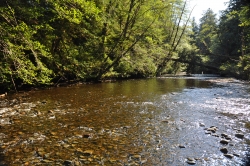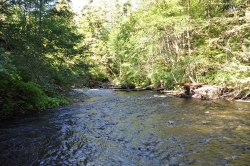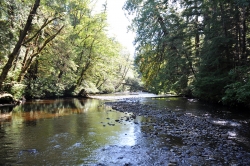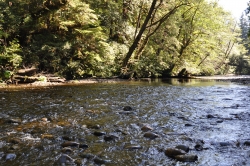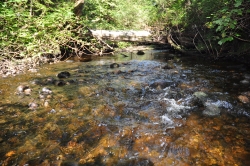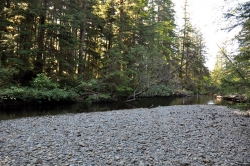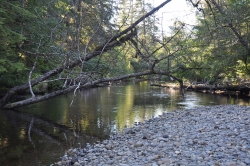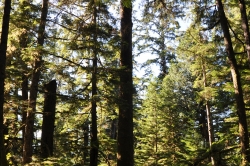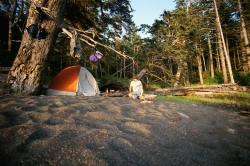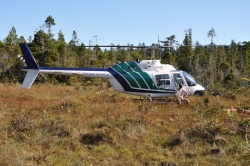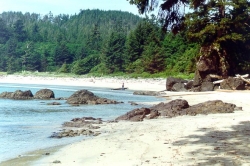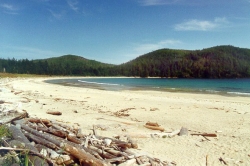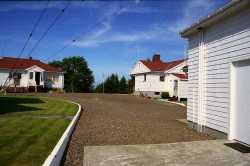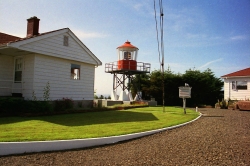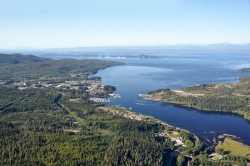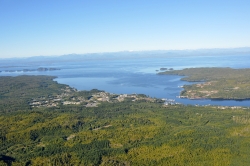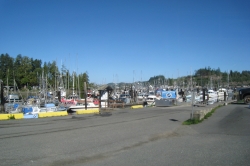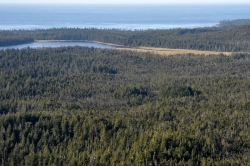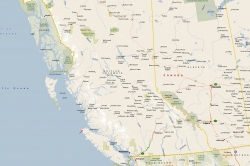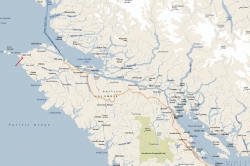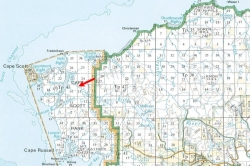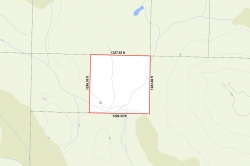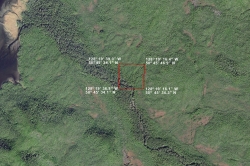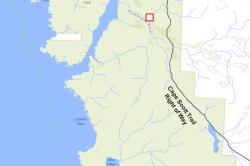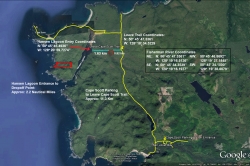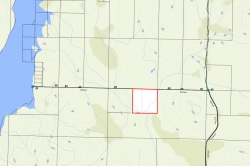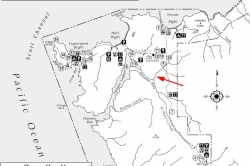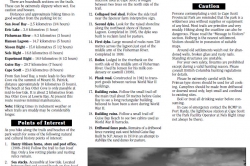Fisherman River
| Listing Number: | Comox 18 |
|---|---|
| Size: | 40 acres – square in shape. |
| Map Reference: | 102I |
| Price: | SOLD |
| Legal: | Northeast 1/4 of Northwest 1/4, Section 13, Township 43, Rupert Land District. |
| Description: | The property is flat and level and is bisected by the Fisherman River which runs through the south boundary and out through the west boundary. A secondary creek runs from the northeast corner joining the Fisherman River near the south boundary. The Fisherman River runs northwest and enters Hanson’s Lagoon a mile and 1/2 northwest of the property. Our research shows a total of 10 private holdings currently in Cape Scott Provincial Park, of which NIHO owns two—Fisherman River and sister parcel Cape Scott. |
| Location: | The property is located on the northwest corner of Vancouver Island, approximately 5 miles (8 km) east of NIHO’s Cape Scott property and situated on the Fisherman River within Cape Scott Provincial Park. |
| Access: | There is no road access. The main Cape Scott trail approaches the area from the south, which heads straight north to Nissen Bight. From this trail a person can take an old existing settler trail due west for approximately half a mile onto the property. Air access is available by floatplane from Coal Harbour, Holberg or Port Hardy to Hansen Lagoon. There is also boat access to Hansen Lagoon. It is approximately 1.6 km from Hansen Lagoon to the property. See mapping section for approximate access. It is very important to note that no constructed trails exist from the main Cape Scott trail to the property or from Hanson Lagoon to the property. |
| Recreation: | Northern Vancouver Island is ideal for the outdoor enthusiast. Cape Scott Provincial Park is ideal for hiking, and has sites for hike-in wilderness camping along the main trail. The Cape itself is attached to Vancouver Island by a sand bridge called Sandy Neck and hikers can climb a wooden plank road to the lighthouse for a spectacular view. The park is a paradise for kayakers with miles of beautiful white sandy beaches offering spectacular scenery. Several varieties of birds are found in the park including blue herons, spotted sandpiper, sandhill cranes, and trumpeter swans. Hansen Lagoon is also a resting area for migrating waterfowl – one of the best on the northwest coast. There is a fairly large population of deer and some elk in the area. Click for Cape Scott Provincial Park Information For the fly-fishermen, Dolly Varden, winter steelhead, cutthroat trout, some sockeye, coho, chinook and chum are all to be found in the Nahwitti River. The Stranby river offers great fishing for winter steelhead, Dolly Varden and fall coho. Port Hardy is an excellent base for saltwater fishing. Sockeye salmon run in June and July, pinks in August, coho in September and chums in October. Steelhead range from 15-20 lbs. Sea going rainbow trout are also good sport. Port Hardy itself has a wide range of recreational facilities including indoor swimming pool, ice arena, curling rink, racquet ball and squash club, tennis courts, two marinas with year round moorage, numerous sport fields, golf course and driving range. |
| Services: | None. |
| Area Data: | The surrounding area of the property is fairly remote, except for hiking trails throughout the park. The nearest main roads for automobiles are some 14 miles (23 kilometres) to the south. There is a lighthouse at Cape Scott 3 miles (4.8 km), located outside the Park, which is inhabited year-round. There is also a ranger station approximately 3½ miles (5.6 km) due north of the property which has two rangers in attendance during the summer months. Cape Scott Provincial Park is a 58 square mile tip of land approximately 30 miles (48 km) west of Port Hardy on the northwest tip of Vancouver Island. Cape Scott Park comprises 55,089 acres of land and 12,608 acres of foreshore and is one of the most beautiful parks in British Columbia. It is characterized by more than 115 km of scenic ocean frontage, including about 30 km of sandy beaches, running from Nissen Bight in the north to San Josef Bay in the south. Rocky promontories and headland intersperse wide sandy beaches. Trails that have been cut by the park administration make for hikes from four to nineteen miles long (one way). Mount St. Patrick at 1,383 feet is the highest point in the park. There are about 200 different species of plant life throughout the park varying from low lying swamps south of the Cape Settlement, to virgin timber at the higher levels. Eric Lake, 44 hectares (108 acres), is the largest body of fresh water in the park. Nearby Nels Bight has a fine-textured white sand beach about a mile and a half long, and considered to be the most impressive of the nine beaches in the park. The beaches in this area are some of the most beautiful beaches in British Columbia. They consist of pure white sands with the waves rolling in and is one of the most spectacular places in British Columbia. The climate of the Cape is unpredictable, with high rainfall and frequent windstorms. Summer months nevertheless offer days of warm sunshine adding to the enjoyment of one of the most spectacular and scenic areas of coastal British Columbia. Port Hardy is a community of 4,008 people situated on a natural deep-water harbour at the north end of Vancouver Island. Mining, logging and fishing forms the current economic base for this community, but tourism and aquaculture are also fast growing industries. Port Hardy is now the second busiest port for aquaculture landings in all of British Columbia – second only to Prince Rupert. Highway 19, the main highway, connects Port Hardy with all major centres on Vancouver Island. Victoria is approximately a seven hours drive on good paved roads. Port Hardy is also the southern terminus for the B.C. Ferries, which connects Vancouver Island with the Inside Passage communities and Prince Rupert, carrying 157 vehicles and 680 passengers per ferry. An airport, with two daily flights from Vancouver, serves the town and smaller charter companies provide commuter service. Port Hardy has a sea-plane base, a helicopter pad and is also home base for a fleet of about 123 commercial fishing vessels, which increases to over 800 from June to October. Port Hardy has one seafood processing plant, two seafood packing plants and a cold storage facility. |
| History: | Three native peoples – the Tlatlasikwala, Nakumgilisala and Yutlinuk – shared the Cape Scott area prior to European settlement. In 1786 Trader Trader James Strange arrived among the coastal islands near the Cape and named them after David Scott, patron of his expedition, and claimed the whole territory for Great Britain. In March of 1897 Rasmus Hansen led the first expedition Danish pioneers to the northern end of Vancouver Island and a colony was established. By 1899 the population was approximately 90 people. Some colonists built their houses of logs and some used whipsawed timbers and boards, but most made use of split cedar, the basic architectural material of the aboriginal Indians. The government promised the colony a road, which was never built, and pre-empted land, which was never granted. Around 1904 the colonist started moving further south around Holberg and San Josef Bay, on pre-empted land. By 1907 there was no port, no store, no post office and no village at Cape Scott. Again in 1910, hardy pioneers arrived at Hansen Lagoon to settle, raise crops and to fish. Today, little remains of the Danish settlement except the names – Nels Bight, Hansen Lagoon, Frederiksen Point, a few fragile buildings and other man-made relics. |
| Vegetation: | Most of the area is covered in old growth timber consisting mainly of cedar and hemlock but with some balsam, spruce, cypress and a few scattered pine. |
| Boundaries: | Surveyed by E. A. Cleveland in March-June, 1897 |
| Taxes: | $315.63 (2019) |
| Zoning: | Rural (A-1) – 10 acre minimum Regional District of Mount Waddington Cape Scott Provincial Park. |


